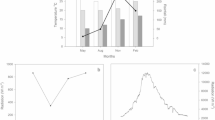Summary
A study was made of the course of the alkaloid content in the aerial parts of both 1- and 2-year-old A. belladonna during growth. This content is not steady. One-year plants reach the maximum content during or just after flowering, when the plant bears a few green berries, while 2-year plants reach the maximum content in a very young stage. During flowering, however, the content drops to a low level to reach a peak again when the plant bears a good many green berries.
When judging the plants for alkaloid content it is important to harvest all plants in the same stage of development. If they are harvested at one time it would be certain that all plants would have been influenced by the same environment for the same length of time. However, a critical comparison of the potentialities of the different plants would not have been achieved.
Similar content being viewed by others
Literature cited
Brewer, W. R. and Hiner, L. D., Cultivation studies of the Solanaceous drugs. IV. Time and space in Solanaceous culture. J. Amer. pharm. Ass. Sci. Ed. 39 (1950): 639–640.
Carr, F. H., The effect of cultivation upon the alkaloidal content of Atropa belladonna L. Chemist and Druggist 8 (1912): 42–44.
The cultivation of medicinal plants. Bulletin no. 121, Min. of Agr. and Fish., London, 25 pp. (1948).
Dijkstra, S. P., Verbeterde uitvoering van de door Hegnauer en Flück ontworpen methode voor de snelle bepaling van het alkaloidengehalte van Solanaceeën-drogerijen. Pharm. Weekbl. 86 (1951): 129–133.
Elzenga, G., Smeets, L. and Bruyn, J. W.de, Influence of the temperature on growth and alkaloid content of first-year Atropa belladonna L. Euphytica 5 (1956): 276–280.
Evans, W. C. and Partridge, M. W., Alkaloid biogenesis. Part II. Changes in the ontogenetic production of alkaloids in Atropa and Datura. J. Pharm. Pharmacol. 5 (1953): 772–777.
Romeike, A., Beiträge zur Chemischen Physiologie der mydriatisch wirkenden Solanaceen-Alkaloide. Die Pharmazie 8 (1953): 668–674; 729–747.
Rowson, J. W., The pharmacognosy of Atropa belladonna L. J. Pharm. Pharmacol. 2 (1950): 201–216.
Sievers, A. F., The possibility and value of improving the commercial belladonna crop through selection. Amer. J. Pharm. 88 (1916): 193–215.
Steinegger, E., Untersuchungen über die Vererbung des Alkaloidgehaltes bei Datura. Pharm. Acta Helv. 27 (1952): 311–314.
Author information
Authors and Affiliations
Rights and permissions
About this article
Cite this article
Elzenga, G., de Bruyn, J.W. Interrelation of alkaloid content and stage of development of 1- and 2-year-old Atropa belladonna L.. Euphytica 5, 259–266 (1956). https://doi.org/10.1007/BF00038847
Received:
Issue Date:
DOI: https://doi.org/10.1007/BF00038847



